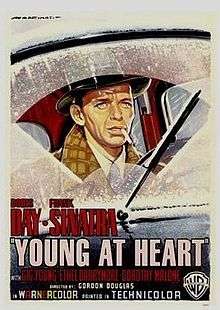Young at Heart (1955 film)
| Young at Heart | |
|---|---|
 Theatrical release poster | |
| Directed by | Gordon Douglas |
| Produced by | Henry Blanke |
| Written by |
Lenore J. Coffee Julius J. Epstein Fannie Hurst (story) |
| Starring |
Doris Day Frank Sinatra Gig Young Ethel Barrymore |
| Cinematography | Ted D. McCord |
| Edited by | William H. Ziegler |
| Distributed by | Warner Bros. |
Release dates |
|
Running time | 117 minutes |
| Country | United States |
| Language | English |
| Box office | $2.5 million (US)[2] |
Young at Heart is a 1955 musical film starring Doris Day and Frank Sinatra, directed by Gordon Douglas, and featuring a supporting cast including Gig Young, Ethel Barrymore, Alan Hale, Jr. and Dorothy Malone. The picture was the first of five films that Douglas directed involving Sinatra and was a remake of the 1938 film Four Daughters.
Plot
When songwriter Alex Burke (Gig Young) enters the lives of the musical Tuttle family, each of the three daughters falls for him. The family lives in the fictional town of Strafford, Connecticut. Alex's personality is a match for Laurie Tuttle (Doris Day), as both she and Alex are seemingly made for each other. A friend of Alex's, Barney Sloan (Frank Sinatra), comes to the Tuttle home to help with some musical arrangements, complications arise. His bleak outlook on life couldn't be any more contradictory to Alex's, Laurie tries to change his negative attitude. Meanwhile, Laurie's two other sisters, Fran who is engaged to Bob (Dorothy Malone), and Amy (Elisabeth Fraser), have feelings for Alex. The family welcomes Barney into their lives, a feeling of genuine self-worth escapes him, however he is falling in love with Laurie. Alex proposes to Laurie and she accepts, which causes Fran to finally marry Bob and devastating Amy. Aunt Jesse is the only one that knows Amy loves Alex. When Laurie goes to see Barney about attending the wedding he tells her he loves her and that Amy loves Alex, she doesn't believe him until she goes home and sees Amy crying. She then leaves Alex at the altar and elopes with Barney. At Christmas Laurie and Barney go home for the holiday, Laurie tells Amy how much she loves Barney and she is pregnant, she hasn't told Barney yet. Amy has since fallen in love with Ernie. Alex is also there for the holiday and has found success. With a black cloud perpetually hanging over his head, Barney decides to go with Bob to take Alex to the train. He drops Bob off at the store and after dropping Alex at the train decides to kill himself, feeling that Laurie would be better off with Alex, as he was a better provider. Barney drives into oncoming traffic during a snowstorm with his windshield wipers off. Barney lives, and with a newfound affirmation of life, finally writes the song he had been working on, finding his self-esteem in the arms of Laurie and their new baby.
Original ending
The character of the self-destructive Barney Sloan was originally written to die at the end of the film when Sloan drives into on-coming traffic during a snow-storm. Sinatra, whose characters in his two previous films (From Here to Eternity [1953] and Suddenly [1954]) perished at the end, thought Sloan should live and find happiness. Sinatra's growing influence in Hollywood was enough to have the ending re-written to accommodate his wishes.
Cast
- Doris Day - Laurie Tuttle
- Frank Sinatra - Barney Sloan
- Gig Young - Alex Burke
- Ethel Barrymore - Jessie Tuttle
- Dorothy Malone - Fran Tuttle
- Elisabeth Fraser - Amy Tuttle
- Robert Keith - Gregory Tuttle
- Alan Hale Jr. - Robert Neary
- Lonny Chapman - Ernest "Ernie" Nichols
Accolades
The film is recognized by American Film Institute in these lists:
- 2002: AFI's 100 Years...100 Passions – Nominated[3]
Score and soundtrack
When this film was released, the conductor Ray Heindorf was not given credit, because of the new ruling at that time that stated that he had to be credited as a "Music Supervisor and conducted by" policy, which he disliked. This is one of the Warner musicals that bears no credit to any composer or conductor.
Songs from the soundtrack were released as an album by Frank Sinatra and Doris Day, also titled Young at Heart. The album peaked at #11 on Billboard while the single reached #2 and was considered as Sinatra's comeback single after several years away from the top of the pop singles chart. So popular was the song "Young at Heart" that the film was also titled Young at Heart, having had no title until the song's success. The song's popularity led to its being used not only for the title, but also for music over the opening and closing credits.
Iconic resonance
Frank Sinatra's persona in the film Young at Heart helped somewhat cultivate the image of the romantic loner that was often personified in the singer's albums. Sinatra's outstanding musical solo-pieces alone at a piano with shot glass, tilted hat and dangling cigarette, helped establish an oft-identified image with the singer/actor.
References
- ↑ "Young at Heart". American FIlm Institute. Retrieved 8 August 2016.
- ↑ 'The Top Box-Office Hits of 1955', Variety Weekly, January 25, 1956
- ↑ "AFI's 100 Years...100 Passions Nominees" (PDF). Retrieved 2016-08-20.